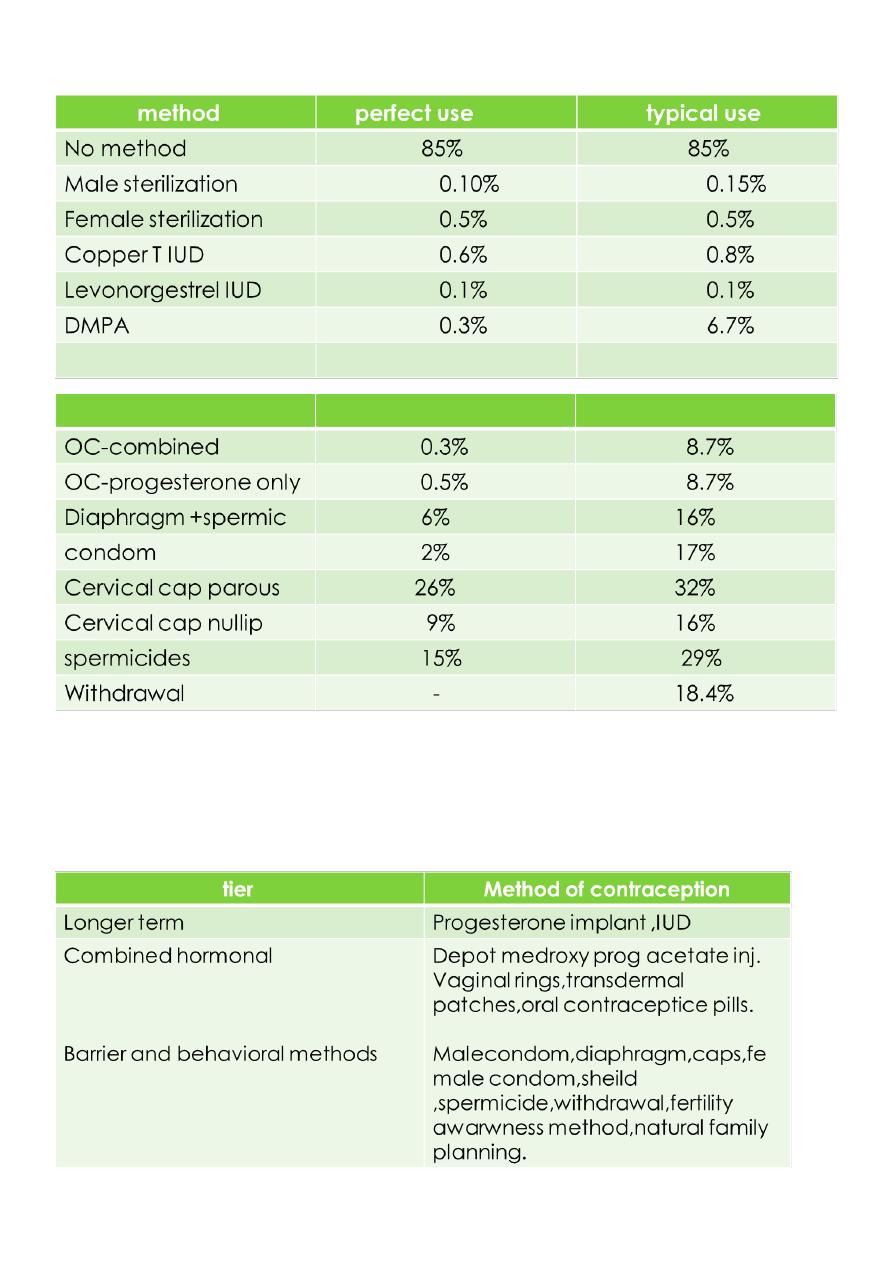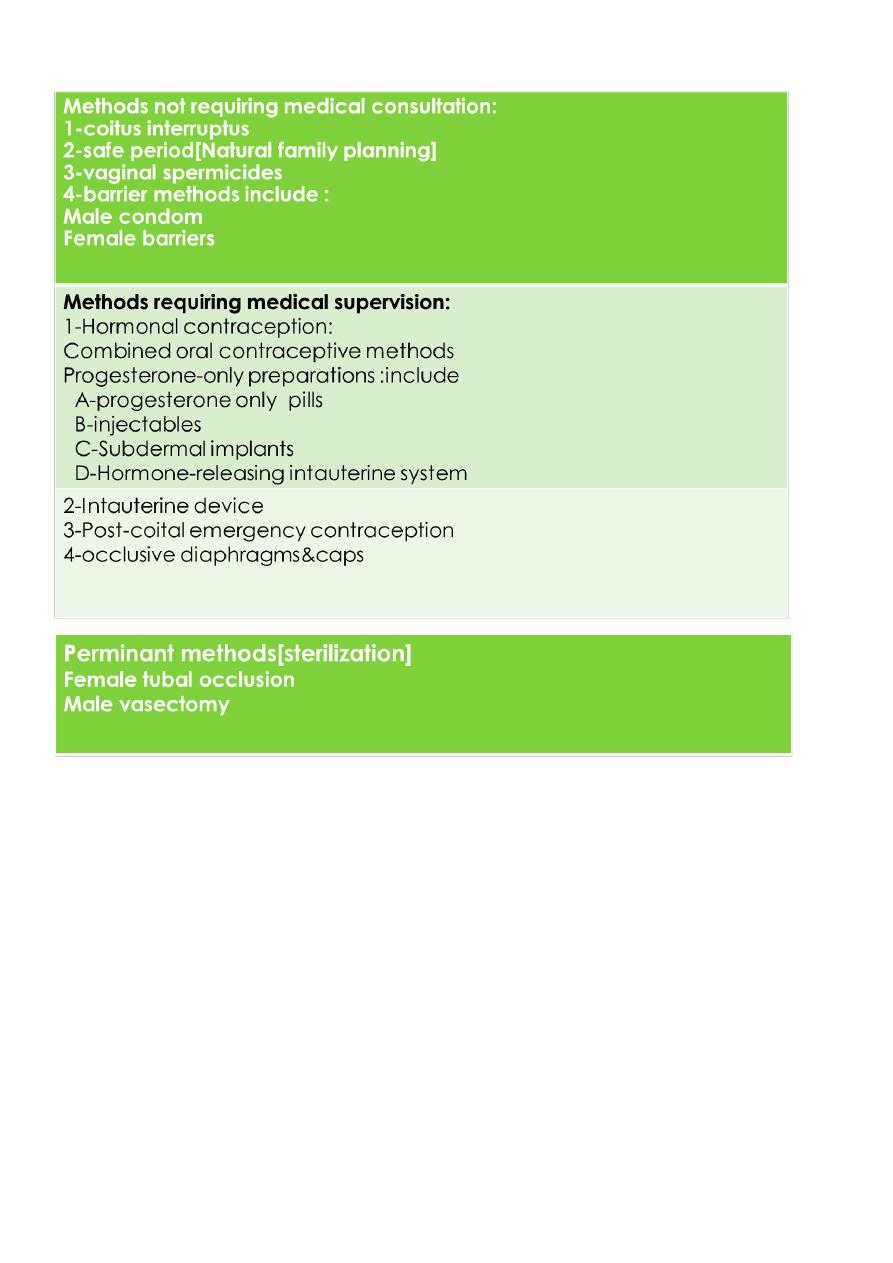
1
Fifth stage
GYNECOLOGY
Lec
د.أسماء
17/10/2016
Fertility control and contraception
Family planning plays a critical role in promoting personal health of the women ,optimizing
both maternal and fetal well being
Every year 600000 women die world wide from pregnancy and pregnancy related causes.
In developing countries the estimated average annual risk of dying from causes related to
pregnancy and childbirth may be about 1 85 per 100,000 women not using contraception.
3 million women suffer significant perminant disabilities.
Many STD can be prevented by contraception. (HIV )infection.
There is no one method that will suit everyone, and individuals will use different types
of contraception at different stages in their lives.
the ideal contraceptive method should:
• highly effective
• no side effects
• cheap
• rapidly reversible
• widespread availability
• acceptable to all cultures and religions
• easily distributed
• can be administrated by non- health care personel.
As effective as modern contraceptives have been , they have not yet achieved their full
potential.
Many unintended pregnancies still occur in a women who are using contraception but are not
using their chosen method correctly.
Virtually all methods of contraception occasionally fail and some are much more effective
than others.
Failure rates are traditionally expressed as the number of failures per 100 woman-years
(HwY ), i.e. the number of pregnancies if 100 women were to use the method for1 year.
Failure rates for some methods vary considerably, largely because of the potential for failure
caused By imperfect use (user failure) rather than an Intrinsic.

2
Contraceptive failure rate comparing typical use and perfect use:
Classification:
Combined oral contraceptive methods are grouped into tiers depending on their
efficacy with typical use.

3
Classification :-
Combined oral contraceptive pills(the pill)
• first licensed in the UK in 1961. It contains a combination of two hormones: a
synthetic oestrogen and progestogen available as once daily pill.
• Since COC was first introduced, the doses of both oestrogen and progestogen have
been reduced dramatically,which has considerably improved its safetyprofile..
• Combined oral contraception is easy to use and offers a very high degree of protection
against pregnancy, with many other beneficial effects. It is mainly used by young,
healthy women.
Formulation: Combined oral contraceptive pills contains both:
1-Synthetic Estrogen (Ethinyl estradiol mostly): The dose of oestrogen varies from 50 to 15
μg.

4
2-Synthetic progestogens : Either one of these :
*First generation(e.g. norethindrone).
*Second generation progestins (e.g. levonorgestrel) .
*Third generation series including gestodene, desogestrel and norgestimate
Monophasic pills contain standard daily dosages of oestrogen and progestogen.
Biphasic or triphasic preparations have two or three incremental variations in
hormone dose.
Current thinking is that biphasic and triphasic preparations are more complicated for women
to use and have few real advantages.
For maximum effectiveness, COC Most brands contain 21 pills; one pill to be taken daily,
followed by a 7-day pill-free interval. There are also some every-day (ED) preparations that
Include seven placebo pills that are taken instead of having a pill-free interval should always
be taken regularly at roughly the same time each day. Other are for extended cycle use to
eliminate or minimize the number of scheduled bleeding episode induced by placebo pills .
This scheduled bleeding is not medically indicated but desired by some women for personal
reason.
preparation
1.low-dose pills containing 30μg of ethinyl estradiol
2.high-dose pills contain contain 50 μg estrogen. Higher dosages of oestrogen are strongly
linked to increased risks of both arterial and venous thrombosis.
3.Yasmin: contains ethinyl estradiol and drospirenone.
Drospirenone has antimineralocorticoid activity. It can help prevent bloating, weight gain,
and hypertension, but it can increase serum potassium.
Yasmin is contraindicated in patients at risk for hyperkalemia and should not be combined
with other drugs that can increase potassium
Mode of action
Combined oral contraception acts both centrally And peri pherally .
•centrally Inhibition of ovulation is by far the most important effect. Both oestrogen and
progestogen suppress the release of pituitary FSH and LH, which prevents follicular
development within the ovary and therefore ovulation .
• Peripheral effects include
- Making endomtrium atrophic and hostile to an implanting embryo
- altering cervical mucus to prevent sperm ascending into the uterine cavity.

5
Contraindication:
absolute:
1• Circulatory diseases:
- ischaemic heart disease- cerebrovascular accident
- significant hypertension
- arterial or venous thrombosis
- any acquired or inherited pro-thrombotic tendency
- any Significant risk factors for cardiovascular disease
2• Acute or severe liver disease
3• Oestrogen-dependent neoplasms, particularly breast cancer
4.Breastfeeding <6 weeks post-partum
5.Smoking ≥15 cigarettes/day and age ≥35
6.Focal migraine
Relative
• Generalized migraine
• Long-term immobilization
• Irregular vaginal bleeding (until a diagnosis has been made)
• Less severe risk factors for cardiovascular disease ,e.g. obesity, heavy smoking, diabetes
Side effect:
1-Venous thromboembolism:
VTE is the major measurable risk other wise the combined oral contraceptive pills are
very safe.
Oestrogens alter blood clotting and coagulation in away that induces a pro-thrombotic
tendency, although the exact mechanism of this is poorly understood.
The higher the dose of oestrogen within COc, the greater the risk of venous
thromboembolism (VTE)...
Type of progestogen also affects the risk of VTE, with users of COC containing third-
generation progestogens
being twice as likely to sustain a VTE.

6
The risks of VTE are:
• 5 per 100 000 for normal population,
15 per 100 000 for users of 2
nd
generation.
30 per 100 000 for users of 3
rd
generation.
60 per 100 000 for pregnant women.
2- Arterial disease
risk of hypertention
1 per cent of COC users will become significantly hypertensive and they should be advised
to stop taking COC
.
risk of myocardial infarction and thrombotic
stroke :in young, healthy women using low-dose COC is extremely small
Cigarette smoking will, however, increase the arterial risk, and any woman who smokes
must
be advised to stop COC at the age of 30years
3- Mortality
There is increased mortality in women using the pills over women not using it, related to
age&smoking habits
Death is most often the result of pulmonary embolism,cerebral or coronary thrombosis
.
Women who are under 35 years, do not Smoke nor have hypertention or diabetes have no
exess mortality
otherwise women over 35 years ,women who Smoke or have hypertention there is excess
mortality .
4.Carcinogenic effect:
Breast cancer : Most data do show a slight increase in the risk of developing breast cancer
among current COC users (relative risk around l. 24).
This is not of great significance to young women, as the background rate of breast cancer is
very low at their age.
However, for a woman in their forties, these are more relevant data, as the background rate
of breast cancer is Higher, but beyond 10 years after stopping coc
there was no increase in breast cancer risk for former coc users
.
Cervical cancer
More than five years of pill use may be associated with small increase risk of
cervical carcinoma.

7
Liver cancer
Benign hepatic adenoma is a rare consequence of COC use
Minor side effects :
1- CNS :
•
Depression
•
Headaches
•
Loss of libido
2-Gastrointestinal :
•
Nausea and vomiting
•
Weight gain
•
Bloatedness
•
Gall-stones
•
Cholestatic jaundice
3-Genitourinary system :
•
Cystitis
•
Irregular bleeding
•
Vaginal discharge
•
Growth of fibroids
4-Breast :
•
Breast pain
•
breast cancer
Increased risk of
5-Miscellaneous
SH.J
